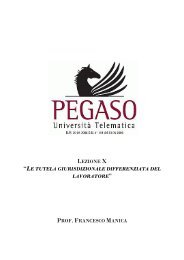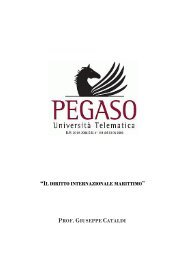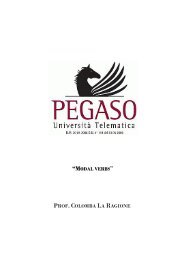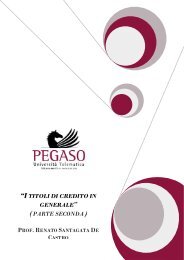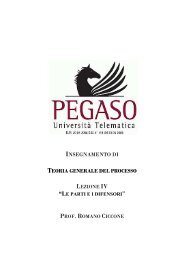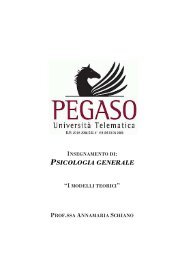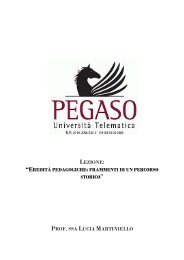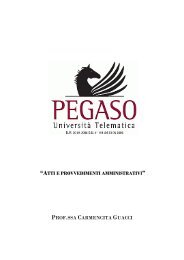il verbo to have, sostantivi, aggettivi e pronomi - Università ...
il verbo to have, sostantivi, aggettivi e pronomi - Università ...
il verbo to have, sostantivi, aggettivi e pronomi - Università ...
You also want an ePaper? Increase the reach of your titles
YUMPU automatically turns print PDFs into web optimized ePapers that Google loves.
“IL VERBO TO HAVE, SOSTANTIVI, AGGETTIVI E PRONOMI”<br />
PROF.SSA COLOMBA LA RAGIONE
Università Telematica Pegaso<br />
Indice<br />
Il <strong>verbo</strong> <strong>to</strong> <strong>have</strong>, <strong>sostantivi</strong>,<br />
<strong>aggettivi</strong> e <strong>pronomi</strong><br />
1 VERBO AVERE E SUOI USI PARTICOLARI ------------------------------------------------------------------------- 3<br />
2 SOSTANTIVI NUMERABILI E NON NUMERABILI ---------------------------------------------------------------- 9<br />
3 AGGETTIVI E PRONOMI INDEFINITI-------------------------------------------------------------------------------- 11<br />
4 GENITIVO SASSONE ------------------------------------------------------------------------------------------------------- 15<br />
5 AGGETTIVI E PRONOMI POSSESSIVI ------------------------------------------------------------------------------- 17<br />
6 COMPARATIVO DI MAGGIORANZA E DI MINORANZA ------------------------------------------------------ 20<br />
BIBLIOGRAFIA --------------------------------------------------------------------------------------------------------------------- 22<br />
Attenzione! Ques<strong>to</strong> materiale didattico è per uso personale dello studente ed è coper<strong>to</strong> da copyright. Ne è severamente<br />
vietata la riproduzione o <strong>il</strong> riut<strong>il</strong>izzo anche parziale, ai sensi e per gli effetti della legge sul dirit<strong>to</strong> d’au<strong>to</strong>re<br />
(L. 22.04.1941/n. 633)<br />
2 di 22
Università Telematica Pegaso<br />
1 Verbo avere e suoi usi particolari<br />
Il <strong>verbo</strong> <strong>to</strong> <strong>have</strong>, <strong>sostantivi</strong>,<br />
<strong>aggettivi</strong> e <strong>pronomi</strong><br />
Il <strong>verbo</strong> avere (“<strong>to</strong> <strong>have</strong>” / “<strong>to</strong> <strong>have</strong> got”) si usa per indicare <strong>il</strong> possesso di cose materiali (1);<br />
relazioni di parentela (2); stati di malessere/malattia (3); caratteristiche fisiche(4):<br />
(1) I’ve got many books if you want <strong>to</strong> borrow some = Ho molti libri se vuoi prenderne qualcuno<br />
in presti<strong>to</strong><br />
(2) I’ve got two younger brothers = Ho due fratelli piú piccoli<br />
(3) I’ve got a terrible headache this morning = Stamattina ho un terrib<strong>il</strong>e mal di testa<br />
(4) She’s got blue eyes and curly hair = Ha gli occhi azzurri e i capelli ricci<br />
La coniugazione del <strong>verbo</strong> è la seguente:<br />
- Forma - Forma<br />
- Esempi<br />
affermativa<br />
affermativa<br />
contratta<br />
I <strong>have</strong> got I’ve got I’ve got a bad s<strong>to</strong>mach ache<br />
(ho un brut<strong>to</strong> mal di<br />
s<strong>to</strong>maco)<br />
You <strong>have</strong> got You’ve got You’ve got a lot of time (hai<br />
mol<strong>to</strong> tempo a disposizione)<br />
She/He /It has got She/He /It’s got She/He /It’s got some<br />
character (ha del carattere)<br />
We <strong>have</strong> got We’ve got We’ve got numerous<br />
requests (abbiamo svariate<br />
richieste)<br />
You <strong>have</strong> got You’ve got You’ve got the same taste<br />
(avete gli stessi gusti)<br />
They <strong>have</strong> got They’ve got They’ve got two lovely kids<br />
(hanno due bimbi adorab<strong>il</strong>i)<br />
Tabella 1: Forma affermativa e forma affermativa contratta del <strong>verbo</strong> “<strong>have</strong> got”<br />
Attenzione! Ques<strong>to</strong> materiale didattico è per uso personale dello studente ed è coper<strong>to</strong> da copyright. Ne è severamente<br />
vietata la riproduzione o <strong>il</strong> riut<strong>il</strong>izzo anche parziale, ai sensi e per gli effetti della legge sul dirit<strong>to</strong> d’au<strong>to</strong>re<br />
(L. 22.04.1941/n. 633)<br />
3 di 22
Università Telematica Pegaso<br />
Il <strong>verbo</strong> <strong>to</strong> <strong>have</strong>, <strong>sostantivi</strong>,<br />
<strong>aggettivi</strong> e <strong>pronomi</strong><br />
Il <strong>verbo</strong> “<strong>have</strong> got” si comporta come <strong>verbo</strong> aus<strong>il</strong>iare. Di conseguenza, come per <strong>il</strong> <strong>verbo</strong> essere<br />
(Lezione 1), la negazione si forma semplicemente aggiungendo “not” dopo <strong>il</strong> <strong>verbo</strong> (Tabella 2),<br />
mentre la frase interrogativa si ottiene con un’inversione del sogget<strong>to</strong> che segue <strong>il</strong> <strong>verbo</strong> “<strong>have</strong>”<br />
(Tabella 3):<br />
- Forma - Forma<br />
- Esempi<br />
negativa<br />
negativa<br />
Contratta<br />
I <strong>have</strong> not got I <strong>have</strong>n’t got I <strong>have</strong>n’t got a driving<br />
licence (non ho la patente)<br />
You <strong>have</strong> not got You <strong>have</strong>n’t got You <strong>have</strong>n’t got an easy task<br />
(non hai un compi<strong>to</strong> fac<strong>il</strong>e)<br />
She/He /It has not got She/He /It hasn’t got She/He /It hasn’t got enough<br />
energy (non ha abbastanza<br />
energia)<br />
We <strong>have</strong> not got We <strong>have</strong>n’t got We <strong>have</strong>n’t got any<br />
questions (non abbiamo<br />
alcuna domanda da fare)<br />
You <strong>have</strong> not got You <strong>have</strong>n’t got You <strong>have</strong>n’t got any<br />
competence (non avete<br />
alcuna competenza)<br />
They <strong>have</strong> not got They <strong>have</strong>n’t got They <strong>have</strong>n’t got any money<br />
(non hanno denaro)<br />
Tabella 2: Forma negativa e forma negativa contratta del <strong>verbo</strong> “<strong>have</strong> got”<br />
Attenzione! Ques<strong>to</strong> materiale didattico è per uso personale dello studente ed è coper<strong>to</strong> da copyright. Ne è severamente<br />
vietata la riproduzione o <strong>il</strong> riut<strong>il</strong>izzo anche parziale, ai sensi e per gli effetti della legge sul dirit<strong>to</strong> d’au<strong>to</strong>re<br />
(L. 22.04.1941/n. 633)<br />
4 di 22
Università Telematica Pegaso<br />
Il <strong>verbo</strong> <strong>to</strong> <strong>have</strong>, <strong>sostantivi</strong>,<br />
<strong>aggettivi</strong> e <strong>pronomi</strong><br />
- Forma - Esempi Forma interrogativa<br />
interrogativ<br />
negativa<br />
a<br />
Have I got<br />
Have I got any day off Haven’t I got any day<br />
(ho qualche giorno off (non ho qualche<br />
libero)<br />
giorno libero)<br />
Have you got Have you got a minute Haven’t you got a<br />
(hai un attimo da minute (non hai un<br />
dedicarmi)<br />
attimo da dedicarmi)<br />
Has She/He /It got Has She/He /It got a Hasn’t She/He /It got a<br />
problem (ha un problem (non ha un<br />
problema)<br />
problema)<br />
Have we got<br />
Have we got enough Haven’t we got enough<br />
time (abbiamo tempo a time (non abbiamo<br />
sufficienza)<br />
tempo a sufficienza)<br />
Have you got Have you got your Haven’t you got your<br />
handout (avete la vostra<br />
dispensa)<br />
handout (non avete la<br />
vostra dispensa)<br />
Have they got Have they got any plan in Haven’t they got any<br />
particular (hanno un plan in particular (non<br />
proget<strong>to</strong> in particolare) hanno un proget<strong>to</strong> in<br />
particolare)<br />
Tabella 3: Forma interrrogativa e interrogativa-negativa del <strong>verbo</strong> “<strong>have</strong> got”<br />
Nel <strong>verbo</strong> “<strong>have</strong> got” le risposte brevi sono costituite semplicemente da “Yes” oppure “No” seguiti<br />
dal pronome personale sogget<strong>to</strong> e da “<strong>have</strong>”/“has” (risposta affermativa), oppure da “<strong>have</strong> not”<br />
(“<strong>have</strong>n’t”)/“has not” (“hasn’t”) per la risposta negativa. È importante notare che “got” viene<br />
omesso nelle risposte brevi, come si può evincere dagli esempi riportati nella Tabella 4:<br />
Attenzione! Ques<strong>to</strong> materiale didattico è per uso personale dello studente ed è coper<strong>to</strong> da copyright. Ne è severamente<br />
vietata la riproduzione o <strong>il</strong> riut<strong>il</strong>izzo anche parziale, ai sensi e per gli effetti della legge sul dirit<strong>to</strong> d’au<strong>to</strong>re<br />
(L. 22.04.1941/n. 633)<br />
5 di 22
Università Telematica Pegaso<br />
Il <strong>verbo</strong> <strong>to</strong> <strong>have</strong>, <strong>sostantivi</strong>,<br />
<strong>aggettivi</strong> e <strong>pronomi</strong><br />
- Forma interrogativa - Risposta breve affermativa e<br />
negativa<br />
Have I got any day off<br />
Yes, I <strong>have</strong> / No, I <strong>have</strong> not (I <strong>have</strong>n’t)<br />
Have you got a minute<br />
Yes, you <strong>have</strong> / No, you <strong>have</strong> not (you<br />
<strong>have</strong>n’t)<br />
Has She/He /It got a problem Yes, she/he/it has / No, she/he/it has not<br />
(she/he/it hasn’t)<br />
Have we got enough time Yes, we <strong>have</strong> / No, we <strong>have</strong> not (we <strong>have</strong>n’t<br />
Have you got your handout Yes, you <strong>have</strong> / No, you <strong>have</strong> not (you<br />
<strong>have</strong>n’t)<br />
Have they got any plan in Yes, they <strong>have</strong> / No, they <strong>have</strong> not (they<br />
particular<br />
<strong>have</strong>n’t)<br />
Tabella 4: Risposte brevi<br />
Il <strong>verbo</strong> “<strong>to</strong> <strong>have</strong>” può anche non essere accompagna<strong>to</strong> da “got” (ques<strong>to</strong> uso è mol<strong>to</strong> frequente<br />
nell’inglese americano ad esempio). In tal caso, “<strong>to</strong> <strong>have</strong>” viene usa<strong>to</strong> come <strong>verbo</strong> ordinario, ovvero<br />
con l’aus<strong>il</strong>iare “do”/ “does” per la forma interrogativa (Tabella 6) e “don’t”/ “doesn’t” per la forma<br />
negativa (Tabella 5):<br />
Forma affermativa - Forma negativa<br />
I <strong>have</strong> (I’ve)<br />
I do not <strong>have</strong> (I don’t <strong>have</strong>)<br />
You <strong>have</strong> (You’ve)<br />
You do not <strong>have</strong> (You don’t <strong>have</strong>)<br />
She/He /It has<br />
(She/He /It’s)<br />
She/He /It does not <strong>have</strong><br />
(She/He /It doesn’t <strong>have</strong>)<br />
We <strong>have</strong> (We’ve)<br />
We do not <strong>have</strong> (We don’t <strong>have</strong>)<br />
You <strong>have</strong> (You’ve)<br />
You do not <strong>have</strong> (You don’t <strong>have</strong>)<br />
They <strong>have</strong> (They’ve)<br />
They do not <strong>have</strong> (They don’t <strong>have</strong>)<br />
Tabella 5: Forma affermativa e negativa del <strong>verbo</strong> “<strong>to</strong> <strong>have</strong>” usa<strong>to</strong> (senza “got”) come <strong>verbo</strong><br />
ordinario<br />
Attenzione! Ques<strong>to</strong> materiale didattico è per uso personale dello studente ed è coper<strong>to</strong> da copyright. Ne è severamente<br />
vietata la riproduzione o <strong>il</strong> riut<strong>il</strong>izzo anche parziale, ai sensi e per gli effetti della legge sul dirit<strong>to</strong> d’au<strong>to</strong>re<br />
(L. 22.04.1941/n. 633)<br />
6 di 22
Università Telematica Pegaso<br />
Il <strong>verbo</strong> <strong>to</strong> <strong>have</strong>, <strong>sostantivi</strong>,<br />
<strong>aggettivi</strong> e <strong>pronomi</strong><br />
- Forma<br />
- Forma<br />
- Risposta breve<br />
interrogativa<br />
interrogativa<br />
(affermativa e<br />
- negativa<br />
negativa)<br />
Do I <strong>have</strong> Don’t I <strong>have</strong> Yes, I do / No, I do not<br />
(I don’t)<br />
Do you <strong>have</strong> Don’t you <strong>have</strong> Yes, you do / No, you do not<br />
(you don’t)<br />
Does She/He /It <strong>have</strong> Doesn’t She/He /It <strong>have</strong> Yes, she/he/it does / No,<br />
she/he/it does not<br />
(she/he/it doesn’t)<br />
Do we <strong>have</strong> Don’t we <strong>have</strong> Yes, we do / No, we do not<br />
(we don’t)<br />
Do you <strong>have</strong> Don’t you <strong>have</strong> Yes, you do / No, you do not<br />
(you don’t)<br />
Do they <strong>have</strong> Don’t they <strong>have</strong> Yes, they do / No, they do<br />
not (they don’t)<br />
Tabella 6: Forma interrogativa, interro-negativa e risposte brevi del <strong>verbo</strong> “<strong>to</strong> <strong>have</strong>” usa<strong>to</strong> (senza<br />
“got”) come <strong>verbo</strong> ordinario<br />
Come anticipa<strong>to</strong> nel corso della Lezione 1, <strong>il</strong> <strong>verbo</strong> “<strong>to</strong> <strong>have</strong>” (così come “<strong>to</strong> take”), viene usa<strong>to</strong> in<br />
molte espressioni che si traducono con l’italiano “fare”, “prendere” o con numerosi altri verbi:<br />
To <strong>have</strong> breakfast / lunch / dinner / a cup<br />
of tea…<br />
To <strong>have</strong> something <strong>to</strong> drink/eat<br />
To <strong>have</strong> a look (at something)<br />
To <strong>have</strong> a good time/ fun<br />
To <strong>have</strong> a conversation/talk<br />
To <strong>have</strong> a party<br />
To <strong>have</strong> a holiday<br />
To <strong>have</strong> a rest/nap<br />
Fare colazione, pranzare, cenare,<br />
prendere una tazza di té...<br />
Prendere qualcosa da bere/da mangiare<br />
Dare uno sguardo (a qualcosa)/ dare<br />
un’occhiata<br />
Divertirsi<br />
Fare una conversazione<br />
Organizzare/fare una festa<br />
Fare una vacanza<br />
Riposarsi/schiacciare un pisolino<br />
Attenzione! Ques<strong>to</strong> materiale didattico è per uso personale dello studente ed è coper<strong>to</strong> da copyright. Ne è severamente<br />
vietata la riproduzione o <strong>il</strong> riut<strong>il</strong>izzo anche parziale, ai sensi e per gli effetti della legge sul dirit<strong>to</strong> d’au<strong>to</strong>re<br />
(L. 22.04.1941/n. 633)<br />
7 di 22
Università Telematica Pegaso<br />
Il <strong>verbo</strong> <strong>to</strong> <strong>have</strong>, <strong>sostantivi</strong>,<br />
<strong>aggettivi</strong> e <strong>pronomi</strong><br />
Il <strong>verbo</strong> “<strong>to</strong> <strong>have</strong>” viene anche usa<strong>to</strong> per effettuare degli ordini in contesti del tipo: al ris<strong>to</strong>rante, al<br />
bar, etc.:<br />
Es.<br />
What are you having = Cosa prende<br />
I’ll <strong>have</strong> a glass of white wine = Prendo un bicchiere di vino bianco<br />
I don’t like chicken, I’ll <strong>have</strong> a salad instead = Non mi piace <strong>il</strong> pollo. Prenderò un’insalata<br />
Attenzione! Ques<strong>to</strong> materiale didattico è per uso personale dello studente ed è coper<strong>to</strong> da copyright. Ne è severamente<br />
vietata la riproduzione o <strong>il</strong> riut<strong>il</strong>izzo anche parziale, ai sensi e per gli effetti della legge sul dirit<strong>to</strong> d’au<strong>to</strong>re<br />
(L. 22.04.1941/n. 633)<br />
8 di 22
Università Telematica Pegaso<br />
Il <strong>verbo</strong> <strong>to</strong> <strong>have</strong>, <strong>sostantivi</strong>,<br />
<strong>aggettivi</strong> e <strong>pronomi</strong><br />
2 Sostantivi numerab<strong>il</strong>i e non numerab<strong>il</strong>i<br />
In inglese esiste una distinzione fra <strong>sostantivi</strong> numerab<strong>il</strong>i (countable nouns) e non<br />
numerab<strong>il</strong>i (uncountable nouns).<br />
I <strong>sostantivi</strong> numerab<strong>il</strong>i sono quei <strong>sostantivi</strong> che possono essere numerati e che hanno la forma<br />
singolare e plurale (room/rooms, cigarette/cigarettes, egg/eggs, etc.). Quando un sostantivo<br />
numerab<strong>il</strong>e è al singolare, viene spesso precedu<strong>to</strong> dall’articolo indeterminativo “a”/”an” (“a”<br />
davanti ai <strong>sostantivi</strong> che cominciano per consonante 1 , “an” davanti a quei <strong>sostantivi</strong> che cominciano<br />
per vocale):<br />
- A big room (una grande stanza) > Two big rooms (due grandi stanze)<br />
- A cigarette (una penna) > A packet of cigarettes (un pacchet<strong>to</strong> di sigarette)<br />
- An egg (un uovo) > Six bo<strong>il</strong>ed eggs (sei uova bollite)<br />
I <strong>sostantivi</strong> non numerab<strong>il</strong>i non possono essere contati e si riferiscono a sostanze, materiali (wine,<br />
sugar, iron, gold), qualità (honesty, sensitivity) e concetti astratti (happiness, fairness, knowledge):<br />
- There is some sugar on the table = C’é dello zucchero sul tavolo<br />
- I am buying some m<strong>il</strong>k for <strong>to</strong>morrow = S<strong>to</strong> comprando del latte per domani<br />
Gli uncountable nouns hanno generalmente solo la forma singolare e, rispet<strong>to</strong> all’italiano, non sono<br />
preceduti dall’articolo se usati in senso generale:<br />
- He prefers wine <strong>to</strong> beer = Preferisce <strong>il</strong> vino alla birra<br />
- Honesty is the main thing = L’onestà è la cosa piú importante<br />
Come già accenna<strong>to</strong>, i <strong>sostantivi</strong> non numerab<strong>il</strong>i non hanno la forma plurale. In funzione di ció,<br />
quando si vuole specificare la quantità di un sostantivo non numerab<strong>il</strong>e, lo si fa precedere da un<br />
sostantivo numerab<strong>il</strong>e + “of” (Tabella 7):<br />
1 L’articolo indeterminativo “a” si usa anche davanti a parole che iniziano per “h” aspirata, come “hospital” e “hotel”.<br />
Attenzione! Ques<strong>to</strong> materiale didattico è per uso personale dello studente ed è coper<strong>to</strong> da copyright. Ne è severamente<br />
vietata la riproduzione o <strong>il</strong> riut<strong>il</strong>izzo anche parziale, ai sensi e per gli effetti della legge sul dirit<strong>to</strong> d’au<strong>to</strong>re<br />
(L. 22.04.1941/n. 633)<br />
9 di 22
Università Telematica Pegaso<br />
Il <strong>verbo</strong> <strong>to</strong> <strong>have</strong>, <strong>sostantivi</strong>,<br />
<strong>aggettivi</strong> e <strong>pronomi</strong><br />
- Uncountable - Countable<br />
Bread (pane)<br />
A piece/a slice/a loaf of bread (un<br />
pezzo/una fetta/una pagnotta di pane)<br />
Jam (confettura)<br />
A jar of jam (un barat<strong>to</strong>lo di confettura)<br />
Toothpaste (dentifricio)<br />
A tube of <strong>to</strong>othpaste (un tubet<strong>to</strong> di<br />
dentifricio)<br />
Sugar (zucchero)<br />
A packet of sugar (un pacco di zucchero)<br />
Salt (sale)<br />
A packet/ a pinch of salt (un pacco /un<br />
pizzico di sale)<br />
Advice (consiglio)<br />
A piece of advice (un consiglio)<br />
Information (informazione) A piece of information (un’informazione)<br />
Wine/beer/water (vino, birra, acqua) A bottle/glass of wine/beer/water (una<br />
bottiglia/un bicchiere di vino, birra, acqua)<br />
Rice (riso)<br />
A bowl/a packet/a grain of rice (una<br />
cio<strong>to</strong>la/un pacchet<strong>to</strong>/un granello di riso)<br />
Tabella 7: Uncountable nouns<br />
Altri <strong>sostantivi</strong> che non hanno la forma plurale includono: money (soldi), hair (capelli), furniture<br />
(mob<strong>il</strong>io/mob<strong>il</strong>i), business (affare/affari), shopping (compere):<br />
She has got long curly hair = Ha capelli biondi e lunghi<br />
The new flat hasn’t got any furniture in it = Nel nuovo appartamen<strong>to</strong> non ci sono mob<strong>il</strong>i<br />
Money is not everything = I soldi non sono tut<strong>to</strong><br />
Attenzione! Ques<strong>to</strong> materiale didattico è per uso personale dello studente ed è coper<strong>to</strong> da copyright. Ne è severamente<br />
vietata la riproduzione o <strong>il</strong> riut<strong>il</strong>izzo anche parziale, ai sensi e per gli effetti della legge sul dirit<strong>to</strong> d’au<strong>to</strong>re<br />
(L. 22.04.1941/n. 633)<br />
10 di 22
Università Telematica Pegaso<br />
3 Aggettivi e <strong>pronomi</strong> indefiniti<br />
Il <strong>verbo</strong> <strong>to</strong> <strong>have</strong>, <strong>sostantivi</strong>,<br />
<strong>aggettivi</strong> e <strong>pronomi</strong><br />
Per esprimere una quantitá indefinita, si ricorre in inglese a “some” ed “any”, che<br />
corrispondono al partitivo italiano (“un pò di”, “del”, “della/e”, “degli/dei”, “qualche”, “alcune/i”,<br />
ecc.). “Some” ed “any” possono essere usati sia con i <strong>sostantivi</strong> numerab<strong>il</strong>i (“some oranges”, “any<br />
pho<strong>to</strong>copies”) che con i <strong>sostantivi</strong> non numerab<strong>il</strong>i (“some time”, “any butter”).<br />
“Some” si usa:<br />
1) nelle frasi affermative:<br />
There is st<strong>il</strong>l some m<strong>il</strong>k in the fridge.<br />
I am buying some sugar and some<br />
chocolate <strong>to</strong> make a cake.<br />
C’è ancora del latte in frigo<br />
S<strong>to</strong> comprando del latte e del cioccola<strong>to</strong><br />
per preparare una <strong>to</strong>rta<br />
2) nelle frasi interrogative quando si vuole offrire oppure chiedere qualcosa:<br />
Do you want some tea<br />
Can you pass me some bread please.<br />
Vuoi un pò di tè<br />
Mi passi un pò di pane per favore<br />
“Any” si usa invece nelle frasi interrogative e in quelle negative:<br />
Sorry, we <strong>have</strong>n’t got any bread<br />
Have they got any ch<strong>il</strong>dren<br />
Spiacente, non abbiamo pane.<br />
Hanno figli<br />
Attenzione! Ques<strong>to</strong> materiale didattico è per uso personale dello studente ed è coper<strong>to</strong> da copyright. Ne è severamente<br />
vietata la riproduzione o <strong>il</strong> riut<strong>il</strong>izzo anche parziale, ai sensi e per gli effetti della legge sul dirit<strong>to</strong> d’au<strong>to</strong>re<br />
(L. 22.04.1941/n. 633)<br />
11 di 22
Università Telematica Pegaso<br />
Il <strong>verbo</strong> <strong>to</strong> <strong>have</strong>, <strong>sostantivi</strong>,<br />
<strong>aggettivi</strong> e <strong>pronomi</strong><br />
Rispet<strong>to</strong> a “some” e ad “any”, gli <strong>aggettivi</strong> e i <strong>pronomi</strong> indefiniti qui di segui<strong>to</strong> elencati esprimono<br />
gradi di quantità più specifici:<br />
ALL (tutta/o, tutte/i)<br />
È usa<strong>to</strong> con i <strong>sostantivi</strong> numerab<strong>il</strong>i e non numerab<strong>il</strong>i:<br />
ALL<br />
(tutta/o, tutte/i)<br />
Sostantivi numerab<strong>il</strong>i<br />
Sostantivi non numerab<strong>il</strong>i<br />
- All the students in the room (tutti gli - All the information ava<strong>il</strong>able (tutte le<br />
studenti nell’aula)<br />
informazioni disponib<strong>il</strong>i)<br />
MANY (Molte/molti)<br />
È usa<strong>to</strong> con riferimen<strong>to</strong> ai <strong>sostantivi</strong> numerab<strong>il</strong>i plurali:<br />
MANY<br />
(Molte/i)<br />
Sostantivi numerab<strong>il</strong>i<br />
Sostantivi non numerab<strong>il</strong>i<br />
- They’ve got many plans for the future<br />
(hanno molti progetti per <strong>il</strong> futuro) X<br />
- Have you got many papers <strong>to</strong> correct<br />
(hai molti documenti da correggere)<br />
- No, I <strong>have</strong>n’t got many (no, non molti)<br />
A LOT OF / LOTS OF<br />
Nelle frasi affermative, la funzione di “many” è anche svolta da “a lot of”/“lots of”. A differenza di<br />
“many”, “a lot of” è piú informale ed è usa<strong>to</strong> sia con i <strong>sostantivi</strong> numerab<strong>il</strong>i che con quelli non<br />
numerab<strong>il</strong>i:<br />
A LOT OF / LOTS OF<br />
(Molta/o, Molte/i)<br />
Sostantivi numerab<strong>il</strong>i<br />
Sostantivi non numerab<strong>il</strong>i<br />
- They’ve got a lot of friends<br />
- There is a lot of traffic in the rush hour<br />
(Fiona ha una marea di amici)<br />
(c’è mol<strong>to</strong> traffico nell’ora di punta)<br />
Attenzione! Ques<strong>to</strong> materiale didattico è per uso personale dello studente ed è coper<strong>to</strong> da copyright. Ne è severamente<br />
vietata la riproduzione o <strong>il</strong> riut<strong>il</strong>izzo anche parziale, ai sensi e per gli effetti della legge sul dirit<strong>to</strong> d’au<strong>to</strong>re<br />
(L. 22.04.1941/n. 633)<br />
12 di 22
Università Telematica Pegaso<br />
Il <strong>verbo</strong> <strong>to</strong> <strong>have</strong>, <strong>sostantivi</strong>,<br />
<strong>aggettivi</strong> e <strong>pronomi</strong><br />
MUCH<br />
È generalmente usa<strong>to</strong> nelle frasi negative e interrogative con i <strong>sostantivi</strong> non numerab<strong>il</strong>i:<br />
MUCH<br />
(Molta/o)<br />
Sostantivi numerab<strong>il</strong>i<br />
Sostantivi non numerab<strong>il</strong>i<br />
- We <strong>have</strong>n’t got much time (non<br />
X<br />
abbiamo mol<strong>to</strong> tempo)<br />
- Have you got much work <strong>to</strong> do =<br />
Hai mol<strong>to</strong> lavoro da fare<br />
A FEW<br />
È usa<strong>to</strong> per indicare un numero limita<strong>to</strong> (“alcune/i” “un cer<strong>to</strong> numero di”), anche se non<br />
necessariamente insufficiente. È riferi<strong>to</strong> a <strong>sostantivi</strong> numerab<strong>il</strong>i plurali:<br />
A FEW<br />
(“alcune/i” “un cer<strong>to</strong> numero di”)<br />
Sostantivi numerab<strong>il</strong>i<br />
Sostantivi non numerab<strong>il</strong>i<br />
- I live in London but I <strong>have</strong> got a few<br />
friends in Manchester (vivo a Londra<br />
ma ho alcuni amici a Manchester)<br />
- The airpoirt is only a few k<strong>il</strong>ometres<br />
from here (l’aeropor<strong>to</strong> dista solo<br />
qualche ch<strong>il</strong>ometro da qui)<br />
X<br />
A LITTLE<br />
Come “a few”, anche “a little” è usa<strong>to</strong> per indicare una quantitá limitata (“un pò di”), anche se non<br />
necessariamente scarsa. A differenza di “a few”, è riferi<strong>to</strong> a <strong>sostantivi</strong> non numerab<strong>il</strong>i:<br />
Attenzione! Ques<strong>to</strong> materiale didattico è per uso personale dello studente ed è coper<strong>to</strong> da copyright. Ne è severamente<br />
vietata la riproduzione o <strong>il</strong> riut<strong>il</strong>izzo anche parziale, ai sensi e per gli effetti della legge sul dirit<strong>to</strong> d’au<strong>to</strong>re<br />
(L. 22.04.1941/n. 633)<br />
13 di 22
Università Telematica Pegaso<br />
A LITTLE (“un pò di”)<br />
Sostantivi numerab<strong>il</strong>i<br />
X<br />
Sostantivi non numerab<strong>il</strong>i<br />
- Do you want a little m<strong>il</strong>k with your<br />
coffee (Vuoi un pò di latte nel<br />
caffé)<br />
- Just a little, thank you (gius<strong>to</strong> un pò,<br />
grazie)<br />
Il <strong>verbo</strong> <strong>to</strong> <strong>have</strong>, <strong>sostantivi</strong>,<br />
<strong>aggettivi</strong> e <strong>pronomi</strong><br />
FEW / LITTLE<br />
Sia “few” che “little” indicano scarsitá: mentre “few” é usa<strong>to</strong> in riferimen<strong>to</strong> ai <strong>sostantivi</strong> numerab<strong>il</strong>i,<br />
“little” è impiega<strong>to</strong> con i <strong>sostantivi</strong> non numerab<strong>il</strong>i. Il loro significa<strong>to</strong> corrisponde, rispettivamente,<br />
a “not many” e “not much”:<br />
Sostantivi numerab<strong>il</strong>i Sostantivi non numerab<strong>il</strong>i<br />
FEW<br />
(“poche/i”)<br />
- James has got few friends:<br />
he’s not very sociable (James X<br />
ha pochi amici. Non è mol<strong>to</strong><br />
socievole)<br />
LITTLE<br />
(“poca/poco”) X<br />
- There is little water in the<br />
tank (c’è poca acqua nel<br />
serba<strong>to</strong>io)<br />
Riep<strong>il</strong>ogando:<br />
Sostantivi numerab<strong>il</strong>i<br />
ALL<br />
MANY<br />
A LOT OF<br />
A FEW<br />
FEW<br />
Sostantivi non numerab<strong>il</strong>i<br />
ALL<br />
A LOT OF (affer.)<br />
MUCH (neg. e interr.)<br />
A LITTLE<br />
LITTLE<br />
Tabella 8: Aggettivi e <strong>pronomi</strong> indefiniti<br />
Attenzione! Ques<strong>to</strong> materiale didattico è per uso personale dello studente ed è coper<strong>to</strong> da copyright. Ne è severamente<br />
vietata la riproduzione o <strong>il</strong> riut<strong>il</strong>izzo anche parziale, ai sensi e per gli effetti della legge sul dirit<strong>to</strong> d’au<strong>to</strong>re<br />
(L. 22.04.1941/n. 633)<br />
14 di 22
Università Telematica Pegaso<br />
4 Genitivo sassone<br />
Il <strong>verbo</strong> <strong>to</strong> <strong>have</strong>, <strong>sostantivi</strong>,<br />
<strong>aggettivi</strong> e <strong>pronomi</strong><br />
Il genitivo sassone è un possessivo che deriva dal genitivo latino, usa<strong>to</strong> per esprimere <strong>il</strong><br />
complemen<strong>to</strong> di specificazione. Nel genitivo sassone, <strong>il</strong> possessore può identificarsi con<br />
una persona o un animale:<br />
- This is Andrea’s moped = Ques<strong>to</strong> è <strong>il</strong> mo<strong>to</strong>rino di andrea<br />
- Betty is my dog’s name = Betty è <strong>il</strong> nome della mia cagnolina<br />
un luogo o una cittá:<br />
- This is Italy’s flag = Questa è la bandiera dell’Italia<br />
- This is Edinburgh’s most attractive location = Questa è la principale meta turistica di Edimburgo<br />
un riferimen<strong>to</strong> temporale:<br />
- Today’s temperature is 19° = La temperatura di oggi è di 19°<br />
- Tomorrow’s match is cancelled = La partita di domani è cancellata<br />
- This is a week’s work = Ques<strong>to</strong> è <strong>il</strong> lavoro di una settimana<br />
Il genitivo sassone si costruisce secondo uno schema mol<strong>to</strong> semplice:<br />
Possessore + ’s + Cosa posseduta (senza articolo):<br />
- John’s ideas are simply excellent! = Le idee di John sono semplicemente eccezionali!<br />
- In J<strong>il</strong>l’s new flat there are many rooms and a few windows = Nel nuovo appartamen<strong>to</strong> di J<strong>il</strong>l ci<br />
sono molte stanze e qualche finestra<br />
- St. Paul’s cathedral is famous all over the world = la cattedrale di St. Paul è famosa in tut<strong>to</strong><br />
<strong>il</strong> mondo<br />
I nomi propri di persona che terminano per “s” possono prendere sia “’s” che <strong>il</strong> solo apostrofo:<br />
- James’s bedroom is in a mess! = La camera da let<strong>to</strong> di James é un <strong>to</strong>tale disordine!<br />
- Ross’ cat has got huge green eyes = <strong>il</strong> gat<strong>to</strong> di Ross ha degli enormi occhi verdi<br />
I <strong>sostantivi</strong> che formano <strong>il</strong> plurale regolarmente (aggiungendo una “s”), prendono solo l’apostrofo<br />
per formare <strong>il</strong> genitivo sassone:<br />
- This is the students’ room = Questa è la stanza degli studenti<br />
- My parents’ life is very hectic: they always <strong>have</strong> a lot of things <strong>to</strong> do and a lot of places <strong>to</strong> go = La<br />
vita dei miei geni<strong>to</strong>ri è mol<strong>to</strong> movimentata: hanno sempre tante cose da fare e m<strong>il</strong>le posti da visitare<br />
Attenzione! Ques<strong>to</strong> materiale didattico è per uso personale dello studente ed è coper<strong>to</strong> da copyright. Ne è severamente<br />
vietata la riproduzione o <strong>il</strong> riut<strong>il</strong>izzo anche parziale, ai sensi e per gli effetti della legge sul dirit<strong>to</strong> d’au<strong>to</strong>re<br />
(L. 22.04.1941/n. 633)<br />
15 di 22
Università Telematica Pegaso<br />
Il <strong>verbo</strong> <strong>to</strong> <strong>have</strong>, <strong>sostantivi</strong>,<br />
<strong>aggettivi</strong> e <strong>pronomi</strong><br />
N.B.<br />
Per i <strong>sostantivi</strong> che hanno un plurale irregolare che non termina in “s” (uomo/uomini = man/men;<br />
donna/donne = woman/women; bambino/bambini = ch<strong>il</strong>d/ch<strong>il</strong>dren; dente/denti = <strong>to</strong>oth/teeth),<br />
bisogna semplicemente attenersi allo schema originale presenta<strong>to</strong> sopra:<br />
Possessore + ’s + Cosa posseduta:<br />
E.g.<br />
This is the ch<strong>il</strong>dren’s room = Questa è la stanza dei bambini<br />
E NON: This is the ch<strong>il</strong>drens’ room<br />
Il nome della cosa posseduta può essere omesso per evitare un’inut<strong>il</strong>e ripetizione:<br />
- Whose umbrella is this It’s Helen’s (umbrella) = Di chi è ques<strong>to</strong> ombrello È (l’ombrello) di<br />
Helen<br />
Quando la cosa posseduta corrisponde a specifici luoghi, come ad esempio “house” (casa), “shop”<br />
(negozio), “church” (chiesa), “cathedral” (cattedrale), “restaurant” (ris<strong>to</strong>rante), “hospital”, questa<br />
si omette in quan<strong>to</strong> è considerata sottintesa:<br />
- They are visiting St. Paul’s (cathedral) = Stanno visitando (la cattedrale di) St. Paul.<br />
- I go <strong>to</strong> the baker’s (shop) every morning <strong>to</strong> buy some bread = Vado dal panettiere ogni mattina<br />
per comprare del pane.<br />
- She often goes <strong>to</strong> the hairdresser’s (shop) on Friday afternoon = Spesso va dal parrucchiere <strong>il</strong><br />
venerdì pomeriggio.<br />
- On Saturday we usually go <strong>to</strong> Mary’s (house) for dinner but <strong>to</strong>night we are going <strong>to</strong> “An<strong>to</strong>nio’s”<br />
(restaurant) <strong>to</strong> celebrate our anniversary = Solitamente <strong>il</strong> saba<strong>to</strong> andiamo a cena a casa di Mary ma<br />
stasera stiamo andando “da (al ris<strong>to</strong>rante di) An<strong>to</strong>nio” per festeggiare <strong>il</strong> nostro anniversario.<br />
- I’m going <strong>to</strong> St. Patrick’s (hospital) <strong>to</strong> visit my grandfather = S<strong>to</strong> andando al (l’ospedale di) St.<br />
Patrick per visitare mio nonno.<br />
Al genitivo sassone si preferisce la costruzione “of” + possessore quando <strong>il</strong> possessore è defini<strong>to</strong> da<br />
complementi o da frasi relative:<br />
- What is the name of that girl who is sitting over there = Qual è <strong>il</strong> nome di quella ragazza che sta<br />
seduta laggiú<br />
- This is the restaurant of that famous Italian chef = Ques<strong>to</strong> è <strong>il</strong> ris<strong>to</strong>rante di quel famoso chef<br />
italiano<br />
Attenzione! Ques<strong>to</strong> materiale didattico è per uso personale dello studente ed è coper<strong>to</strong> da copyright. Ne è severamente<br />
vietata la riproduzione o <strong>il</strong> riut<strong>il</strong>izzo anche parziale, ai sensi e per gli effetti della legge sul dirit<strong>to</strong> d’au<strong>to</strong>re<br />
(L. 22.04.1941/n. 633)<br />
16 di 22
Università Telematica Pegaso<br />
5 Aggettivi e Pronomi possessivi<br />
Il <strong>verbo</strong> <strong>to</strong> <strong>have</strong>, <strong>sostantivi</strong>,<br />
<strong>aggettivi</strong> e <strong>pronomi</strong><br />
Mentre in italiano gli <strong>aggettivi</strong> possessivi si concordano con <strong>il</strong> sostantivo a cui si riferiscono,<br />
in inglese abbiamo un aggettivo unico per ogni pronome personale sogget<strong>to</strong>:<br />
Pronome personale sogget<strong>to</strong><br />
Aggettivo possessivo<br />
I<br />
My (mia/mio/mie/miei)<br />
You<br />
Your (tua/tuo/tue/tuoi)<br />
She/ He/ It Her (sua/suo/sue/suoi di lei)<br />
His (sua/suo/sue/suoi di lui)<br />
Its (sua/suo/sue/suoi di essa/o)<br />
We<br />
Our (nostra/nostro/nostre/ nostri)<br />
You<br />
Your (vostra/vostro/vostre/vostri)<br />
They<br />
Their (loro)<br />
Tabella 9: Aggettivi possessivi<br />
A differenza dell’italiano quindi, gli <strong>aggettivi</strong> possessivi in inglese sono invariab<strong>il</strong>i nel genere e nel<br />
numero, cioè hanno la stessa forma sia per <strong>il</strong> masch<strong>il</strong>e che per <strong>il</strong> femmin<strong>il</strong>e, sia per <strong>il</strong> singolare che<br />
per <strong>il</strong> plurale:<br />
My<br />
Mia/Mio /Mie/Miei<br />
Our<br />
Nostra/Nostro/Nostre/Nostri<br />
Etc.<br />
Gli <strong>aggettivi</strong> possessivi, cosí come i nomi propri, gli avverbi di tempo e i ti<strong>to</strong>li di cortesia, non<br />
possono mai essere preceduti dall’articolo:<br />
- This is my teacher’s signature = Questa è la firma del mio insegnante<br />
Come si può notare dalla Tabella 9, per la terza persona singolare abbiamo un aggettivo possessivo<br />
femmin<strong>il</strong>e, uno masch<strong>il</strong>e e uno neutro. A differenza dell’italiano, in inglese gli <strong>aggettivi</strong> possessivi<br />
concordano con <strong>il</strong> possessore e non con la cosa posseduta (His = di lui; Her = di lei):<br />
Attenzione! Ques<strong>to</strong> materiale didattico è per uso personale dello studente ed è coper<strong>to</strong> da copyright. Ne è severamente<br />
vietata la riproduzione o <strong>il</strong> riut<strong>il</strong>izzo anche parziale, ai sensi e per gli effetti della legge sul dirit<strong>to</strong> d’au<strong>to</strong>re<br />
(L. 22.04.1941/n. 633)<br />
17 di 22
Università Telematica Pegaso<br />
Il <strong>verbo</strong> <strong>to</strong> <strong>have</strong>, <strong>sostantivi</strong>,<br />
<strong>aggettivi</strong> e <strong>pronomi</strong><br />
Italian<br />
English<br />
Questa è la bibicletta di mio fratello. È This is my brother’s bike. It is HIS bike.<br />
la sua bicicletta. (concorda con la cosa (concorda con <strong>il</strong> possessore)<br />
posseduta)<br />
Jane sta festeggiando. Oggi è <strong>il</strong> suo Jane is celebrating. Today it’s HER<br />
compleanno. (concorda con la cosa birthday. (concorda con <strong>il</strong> possessore)<br />
posseduta)<br />
Tabella 10 : Aggettivi possessivi “his” e “her”<br />
L’aggettivo possessivo “Its” è invece riferi<strong>to</strong> a cose inanimate o ad animali.<br />
- It’s my dog. Its name is Brownie = è <strong>il</strong> mio cane. Il suo nome è Brownie<br />
N.B.<br />
Nell’esempio sopra riporta<strong>to</strong>, notare la differenza fra “its name is...” (aggettivo possessivo di terza<br />
persona singolare riferi<strong>to</strong> a cose o ad animali) e “It’s my dog” (forma contratta della terza persona<br />
singolare del <strong>verbo</strong> essere “It is”).<br />
In inglese gli <strong>aggettivi</strong> possessivi sostituiscono l’articolo determinativo quando si riferiscono a parti<br />
del corpo:<br />
Italian<br />
English<br />
Non si lava mai le mani prima di He never washes his hands before eating<br />
mangiare<br />
Ha sempre la testa fra le nuvole He has always got his head in the clouds!<br />
Mi fanno male le gambe<br />
My legs hurt<br />
Tabella 11: Aggettivi possessivi usati per indicare parti del corpo<br />
Per quel che concerne i <strong>pronomi</strong> possessivi, in inglese sono i seguenti:<br />
Pronome personale sogget<strong>to</strong><br />
Pronome possessivo<br />
I<br />
Mine (la mia/<strong>il</strong> mio/le mie/i miei)<br />
You<br />
Yours (la tua/<strong>il</strong> tuo/le tue/i tuoi)<br />
She/ He/ It<br />
Hers (la sua/<strong>il</strong> suo/le sue/i suoi di lei)<br />
His (la sua/<strong>il</strong> suo/le sue/i suoi di lui)<br />
Its (la sua/<strong>il</strong> suo/le sue/i suoi di essa/o)<br />
We<br />
Ours (nostra/nostro/nostre/ nostri)<br />
You<br />
Yours (vostra/vostro/vostre/vostri)<br />
Attenzione! Ques<strong>to</strong> materiale didattico è per uso personale dello studente ed è coper<strong>to</strong> da copyright. Ne è severamente<br />
vietata la riproduzione o <strong>il</strong> riut<strong>il</strong>izzo anche parziale, ai sensi e per gli effetti della legge sul dirit<strong>to</strong> d’au<strong>to</strong>re<br />
(L. 22.04.1941/n. 633)<br />
18 di 22
Università Telematica Pegaso<br />
Il <strong>verbo</strong> <strong>to</strong> <strong>have</strong>, <strong>sostantivi</strong>,<br />
<strong>aggettivi</strong> e <strong>pronomi</strong><br />
They<br />
Theirs (loro)<br />
Tabella 12: Pronomi possessivi<br />
I <strong>pronomi</strong> possessivi si usano al pos<strong>to</strong> del nome. Non sono seguiti da un sostantivo, ma lo<br />
sottintendono:<br />
Questa biro è la tua = This pen is yours<br />
La mia macchina non funziona. Perché non prendiamo la tua = My car doesn’t work. Why don’t<br />
we take yours<br />
Cosí come gli <strong>aggettivi</strong> possessivi, in inglese anche i <strong>pronomi</strong> possessivi sono invariab<strong>il</strong>i; non sono<br />
mai preceduti da articolo; alla terza persona singolare concordano in genere e in numero con <strong>il</strong><br />
possessore e non con la cosa posseduta:<br />
- Your work is harder than hers = Il vostro lavoro é piú diffic<strong>il</strong>e del suo<br />
- Julie’s computer is faster and more reliable than his = Il computer di Julie é piú veloce e piú<br />
affidab<strong>il</strong>e del vostro/ dei vostri<br />
Negli esempi sopra riportati, “harder”, “faster” and “more reliable” rappresentano dei comparativi<br />
di maggioranza, che verranno approfonditi nel paragrafo 6.<br />
Attenzione! Ques<strong>to</strong> materiale didattico è per uso personale dello studente ed è coper<strong>to</strong> da copyright. Ne è severamente<br />
vietata la riproduzione o <strong>il</strong> riut<strong>il</strong>izzo anche parziale, ai sensi e per gli effetti della legge sul dirit<strong>to</strong> d’au<strong>to</strong>re<br />
(L. 22.04.1941/n. 633)<br />
19 di 22
Università Telematica Pegaso<br />
Il <strong>verbo</strong> <strong>to</strong> <strong>have</strong>, <strong>sostantivi</strong>,<br />
<strong>aggettivi</strong> e <strong>pronomi</strong><br />
6 Comparativo di maggioranza e di minoranza<br />
Gli <strong>aggettivi</strong> formano <strong>il</strong> grado comparativo aggiungendo <strong>il</strong> suffisso “-er” se si tratta di<br />
<strong>aggettivi</strong> mono e bis<strong>il</strong>labici:<br />
tall (alta/o)> taller<br />
dark (scura/o; buia/o) > darker<br />
fast (rapida/o; veloce) > faster<br />
happy (felice; contenta/o) > happier<br />
Il secondo termine di paragone é sempre precedu<strong>to</strong> da “than” = “rispet<strong>to</strong> a”:<br />
- Edinburgh is bigger than Bris<strong>to</strong>l = Edimburgo é piú grande di Bris<strong>to</strong>l<br />
- In some ways, English is easier than Polish = Sot<strong>to</strong> alcuni aspetti, l’inglese é piú fac<strong>il</strong>e del<br />
polacco<br />
Alcune variazioni morfologiche interessano anche <strong>il</strong> comaprativo di maggioranza:<br />
1) Gli <strong>aggettivi</strong> che terminano per una consonante preceduta da vocale raddoppiano la consonante<br />
prima di aggiungere “-er”:<br />
- Naples is hotter than Venice in the summer = D’estate Napoli é piú calda di Venezia<br />
- Butter is fatter than o<strong>il</strong> = Il burro é piú grasso dell’olio<br />
2) Gli <strong>aggettivi</strong> monos<strong>il</strong>labici o bis<strong>il</strong>labici che terminano per “–y” cambiano la “y” in “i” prima di<br />
aggiungere “–er”:<br />
tidy (ordinata/o) > tidier<br />
dirty (sporca/o) > dirtier<br />
Nel caso degli <strong>aggettivi</strong> pluris<strong>il</strong>labici, <strong>il</strong> comparativo di maggioranza si fa ponendo “more” davanti<br />
all’aggettivo:<br />
- Novels are more interesting than s<strong>to</strong>ries = I romanzi sono piú interessanti dei racconti<br />
- Flying is more expensive than going by car = Volare é piú caro che andare con la macchina<br />
Riep<strong>il</strong>ogando:<br />
Struttura della frase contenente un comparativo di maggioranza:<br />
1° termine di paragone+ Verbo +<br />
More + agg. (pluris<strong>il</strong>labico)<br />
agg. (mono e bis<strong>il</strong>labico) + -er<br />
+ than + 2° termine<br />
Attenzione! Ques<strong>to</strong> materiale didattico è per uso personale dello studente ed è coper<strong>to</strong> da copyright. Ne è severamente<br />
vietata la riproduzione o <strong>il</strong> riut<strong>il</strong>izzo anche parziale, ai sensi e per gli effetti della legge sul dirit<strong>to</strong> d’au<strong>to</strong>re<br />
(L. 22.04.1941/n. 633)<br />
20 di 22
Università Telematica Pegaso<br />
Il <strong>verbo</strong> <strong>to</strong> <strong>have</strong>, <strong>sostantivi</strong>,<br />
<strong>aggettivi</strong> e <strong>pronomi</strong><br />
La possib<strong>il</strong>itá di modificare l’aggettivo con un suffisso non c’é nel comparativo di minoranza, che<br />
segue sempre lo stesso schema:<br />
1° termine di paragone + Verbo + “less” + aggettivo + “than” + 2° termine<br />
- I’m less tired than yesterday = Sono meno stanca di ieri<br />
- New York is less safe than Perugia = New York é meno sicura di Perugia<br />
- Computers are less noisy than old typewriters! = I pc sono meno rumorosi delle vecchie<br />
macchine da scrivere!<br />
Per indicare invece l’uguaglianza fra gli <strong>aggettivi</strong>, in inglese si usa la costruzione “as......as”:<br />
She’s as generous as her mother = E’ generosa quan<strong>to</strong> la madre<br />
N.B.<br />
Il secondo termine di paragone può essere un sostantivo (1), un pronome possessivo (2), un<br />
pronome personale complemen<strong>to</strong> (3): .<br />
(1) The remake is as pleasant as the original = La nuova versione e’ piacevole quan<strong>to</strong> l’originale<br />
(2) Your room is as messy as mine = La tua stanza e’ disordinata quan<strong>to</strong> la mia<br />
(3) She is a big girl now: she is as tall as her father! = E’ una ragazza grande ormai: é alta quan<strong>to</strong> <strong>il</strong><br />
padre!<br />
Prima di concludere, osserviamo qualche caso particolare di comparazione.<br />
Quando si vuole evidenziare la progressiva diminuzione o <strong>il</strong> progressivo aumen<strong>to</strong> di qualcosa<br />
(“sempre piú”/ “sempre meno”), si ripete due volte l’aggettivo comparativo seguendo lo schema:<br />
“forma comparativa” + and + “forma comparativa”<br />
- The cost of living is higher and higher (aggettivo monos<strong>il</strong>labico “high”)= Il cos<strong>to</strong> della vita<br />
e’ sempre piú al<strong>to</strong><br />
- The relationship is becoming more and more complicated (aggettivo pluris<strong>il</strong>labico “boring”)<br />
= La relazione sta diventando sempre piú complicata<br />
- There is less and less water on the planet = C’e’ sempre meno acqua sul pianeta<br />
Attenzione! Ques<strong>to</strong> materiale didattico è per uso personale dello studente ed è coper<strong>to</strong> da copyright. Ne è severamente<br />
vietata la riproduzione o <strong>il</strong> riut<strong>il</strong>izzo anche parziale, ai sensi e per gli effetti della legge sul dirit<strong>to</strong> d’au<strong>to</strong>re<br />
(L. 22.04.1941/n. 633)<br />
21 di 22
Università Telematica Pegaso<br />
Il <strong>verbo</strong> <strong>to</strong> <strong>have</strong>, <strong>sostantivi</strong>,<br />
<strong>aggettivi</strong> e <strong>pronomi</strong><br />
Bibliografia<br />
Giusti G., 2003, Strumenti d'analisi per la lingua inglese, Torino, UTET Libreria.<br />
Murphy R., Pallini L., Essential Grammar in Use (Italian): A Self-Study Reference and<br />
Practice Book for Elementary Students of English: with Answers (Book and CD-ROM),<br />
Cambridge, Cambridge University Press, ultima edizione.<br />
Vince M., First Certificate Language Practice, with Key, Oxford: Heinemann, ultima<br />
edizione.<br />
Attenzione! Ques<strong>to</strong> materiale didattico è per uso personale dello studente ed è coper<strong>to</strong> da copyright. Ne è severamente<br />
vietata la riproduzione o <strong>il</strong> riut<strong>il</strong>izzo anche parziale, ai sensi e per gli effetti della legge sul dirit<strong>to</strong> d’au<strong>to</strong>re<br />
(L. 22.04.1941/n. 633)<br />
22 di 22





